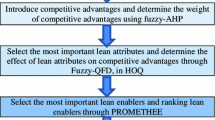Abstract
Nowadays manufacturing organizations are moving towards lean practices to keep pace with the competition. Lean practices mainly focuses on eliminating seven deadly wastes, thereby reducing the cost. Leanness is the measure of lean manufacturing practices. This paper presents the 30 criteria based leanness assessment methodology using fuzzy logic. Fuzzy logic has been used to overcome the disadvantages with scoring method such as impreciseness and vagueness. During this research, a conceptual model for leanness assessment has been designed. Then the fuzzy leanness index which indicates the leanness level of the organization and fuzzy performance importance index which helps in identifying the obstacles for leanness has been computed. The results indicate that the model is capable of effectively assessing leanness and has practical relevance.
Similar content being viewed by others
References
Abdulmalek FA, Rajgopal J (2007) Analyzing the benefits of lean manufacturing and value stream mapping via simulation: a process sector case study. Int J Prod Econ 107:223–236
Al-Najjar A (2002) Selecting the most efficient maintenance approach using fuzzy multiple criteria decision making. Int J Prod Econ 84:85–100
Bayou ME, De Korvin A (2008) Measuring the leanness of manufacturing systems—a case study of Ford Motor Company and General Motors. J Eng Technol Manag 25:287–304
Beskese A, Kahraman C, Irani Z (2004) Quantification of flexibility in advanced manufacturing systems using fuzzy concept. Int J Prod Econ 89:45–56
Carlier J, Hermes F, Moukrim A, Ghedira K (2010) Exact resolution of the one-machine sequencing problem with no machine idle time. Comput Ind Eng 59:193–199
Chan FTS, Lau HCW, Ip RWL, Chan HK, Kong S (2005) Implementation of total productive maintenance: a case study. Int J Prod Econ 95(1):71–94
Chen CT, Lin CT, Huang SF (2006) A fuzzy approach for supplier evaluation and selection in supply chain management. Int J Prod Econ 102:289–301
Chen Y (1997) A measurement of the resource utilization efficiency of university libraries. Int J Prod Res 53:71–80
Dale BG, Lightburn K (1992) Continuous quality improvement: why some organisations lack commitment. Int J Prod Econ 27(1):57–67
Ertay T (1998) Simulation approach in comparison of a pull system in a cell production system with a push system in a conventional production system according to flexible cost: a case study. Int J Prod Econ 56–57:145–155
Gopalakrishnan N (2010) Simplified lean manufacture: elements, rules, tools, and implementation. PHI Learning Private Limited, New Delhi
Govers PM (2001) QFD not just a tool but a way of quality management. Int J Prod Econ 69:151–159
Guesgen HW, Albrecht J (2000) Imprecise reasoning in geographic information systems. Fuzzy Sets and Systems 113:121–131
Hines P, Rich N (1997) The seven value stream mapping tools. Int J of Operat Prod Manag 17(1):46–64
Karsak EE, Tolga E (2001) Fuzzy multi-criteria decision-making procedure for evaluating advanced manufacturing system investments. Int J Prod Econ 69(1):49–64
Land J (2009) A card-based system for job shop control. Int J Prod Res 117:97–103
Lin CT, Chiu H, Tseng YH (2006) Agility evaluation using fuzzy logic. Int J Prod Econ 101:353–368
Perera HSC, Nagarur N, Tabucanon T (1999) Component part standardization: a way to reduce the life-cycle costs of products. Int J Prod Res 60–61:109–116
Petersen K, Wohlin C (2010) Software process improvement through the lean measurement (SPI-LEAM) method. J Syst Softw 83:1275–1287
Pepiot G, Cheikhrouhou N, Furbringer JM, Glarddon R (2008) A fuzzy approach for the evaluation of competences. Int J Prod Econ 112:336–353
Shah R, Ward T (2003) Lean manufacturing: context, practice bundles, and performance. J Oper Manag 21:129–149
Smith R, Hawkins B (2004) Total productive maintenance (TPM). Lean Maintenance 55–104.
Sullivan G, McDonald N, Aken MV (2002) Equipment replacement decisions and lean manufacturing. Rob Comp Integrat Manuf 18:255–265
Vinodh S, Chintha SK (2009) Leanness assessment using multi grade fuzzy approach. Int J Prod Res 49(2):431–445
Wang RC, Chuu SJ (2004) Group decision-making using a fuzzy linguistic approach for evaluating the flexibility in a manufacturing system. Eur J Oper Res 154(3):563–572
Zapfel G (1998) customer- order-driven production: an economical concept for responding to demand uncertainty. Int J Prod Econ 56–57:699–709
Zimniak A, Jozefowska J (2008) Optimization tool for short-term production planning and scheduling. Int J Prod Res 112:109–120
Author information
Authors and Affiliations
Corresponding author
Rights and permissions
About this article
Cite this article
Vinodh, S., Vimal, K.E.K. Thirty criteria based leanness assessment using fuzzy logic approach. Int J Adv Manuf Technol 60, 1185–1195 (2012). https://doi.org/10.1007/s00170-011-3658-y
Received:
Accepted:
Published:
Issue Date:
DOI: https://doi.org/10.1007/s00170-011-3658-y




